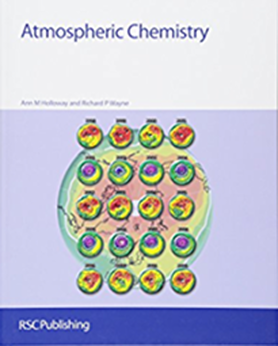Atmospheric Chemistry
This textbook provides a key to understanding the chemistry behind major atmospheric environmental issues, from stratospheric ozone depletion to poor air quality.
|
The first two chapters provide a general description of the composition and physical structure of the Earth’s atmosphere, from its temperature and pressure vertical profiles to how electromagnetic radiation (both incoming from the sun and emitted by the Earth itself) interacts with the atmosphere. In particular, the authors provide a very clear account of the radiative transfer model used to calculate the surface temperature of the Earth, and of the greenhouse effect. In Chapters 3, 5, and 6, before diving into a more detailed overview of the chemical reactions occurring in the atmosphere (from Chapter 8 onwards), the reader is introduced to a number of key concepts in atmospheric science, including sources and sinks of trace gases, the photochemistry of ozone, chemical families, and biogeochemical cycles of elements. Ozone, in particular, is a “recurring character” in this book, which reflects its central role in driving much (if not all) of atmospheric chemistry.
|
Chapter 7 (on the history and evolution of the Earth’s atmosphere) is interesting and well written. The authors explain clearly the various types of feedbacks regulating the Earth’s atmosphere, and the compelling idea that some trace gases (e.g. CO2, DMS) act as “thermostatic controls” for the temperature of our planet. The section on the theories on the evolution of molecular oxygen in the atmosphere was fascinating. Accompanied by details on fossil and mineral evidence, it also addresses the question of the role of oxygen and the protection afforded by the ozone layer from solar UV radiation (therefore, ultimately, of atmospheric photochemistry) in the emergence of life on land after its first appearance in waters. This piqued my interest and inspired me to look further into current studies and theories.
More generally, some of the structure of the book may appear confusing when read front-to-back. Chapter 10, covering the chemistry of the upper layers of the atmosphere (mesosphere and thermosphere), is very interesting as the focus has traditionally been on the lower parts of the atmosphere (troposphere and stratosphere). However, its position following these chapters (8 and 9 respectively) feels out of place, especially as the “narrative” threaded through those chapters builds towards the discussion in Chapter 11 on the adverse influence of humankind on the atmosphere.
Some of the illustrations in the book could be improved on, especially those elucidating concepts the reader might not necessarily be familiar with, such as the lapse rate (how temperature changes with altitude), and the various subtleties between adiabatic, dry and saturated lapse rates. As many atmospheric scientists can attest, this is not the most intuitive concept to explain to students, so including more details in the diagrams would provide invaluable visual help (e.g. showing what happens to an air parcel rising through the troposphere against one in the stratosphere).
Some of the illustrations in the book could be improved on, especially those elucidating concepts the reader might not necessarily be familiar with, such as the lapse rate (how temperature changes with altitude), and the various subtleties between adiabatic, dry and saturated lapse rates. As many atmospheric scientists can attest, this is not the most intuitive concept to explain to students, so including more details in the diagrams would provide invaluable visual help (e.g. showing what happens to an air parcel rising through the troposphere against one in the stratosphere).
Understandably, much progress has been made in atmospheric chemistry since the publication of this book in 2010. I was expecting some topics to be absent or already outdated, but I was pleasantly surprised. One notable example is the chemistry of Criegee intermediates, which generated an intense wave of research only a few years after the publication of this book.
One of the authors already produced a very influential book on this very subject (Richard Wayne’s Chemistry of Atmospheres, now in its third edition), with which some readers may be familiar. As the authors explain in the introduction, Atmospheric Chemistry is designed as an entry-level textbook rather than a reference book. I agree with the authors, and would recommend this book as an excellent introduction to the field.
One of the authors already produced a very influential book on this very subject (Richard Wayne’s Chemistry of Atmospheres, now in its third edition), with which some readers may be familiar. As the authors explain in the introduction, Atmospheric Chemistry is designed as an entry-level textbook rather than a reference book. I agree with the authors, and would recommend this book as an excellent introduction to the field.
Reference
Ann M. Holloway and Richard P. Wayne, Atmospheric Chemistry, Royal Society of Chemistry, Cambridge, 2010
ISBN: 9781847558077
Ann M. Holloway and Richard P. Wayne, Atmospheric Chemistry, Royal Society of Chemistry, Cambridge, 2010
ISBN: 9781847558077


